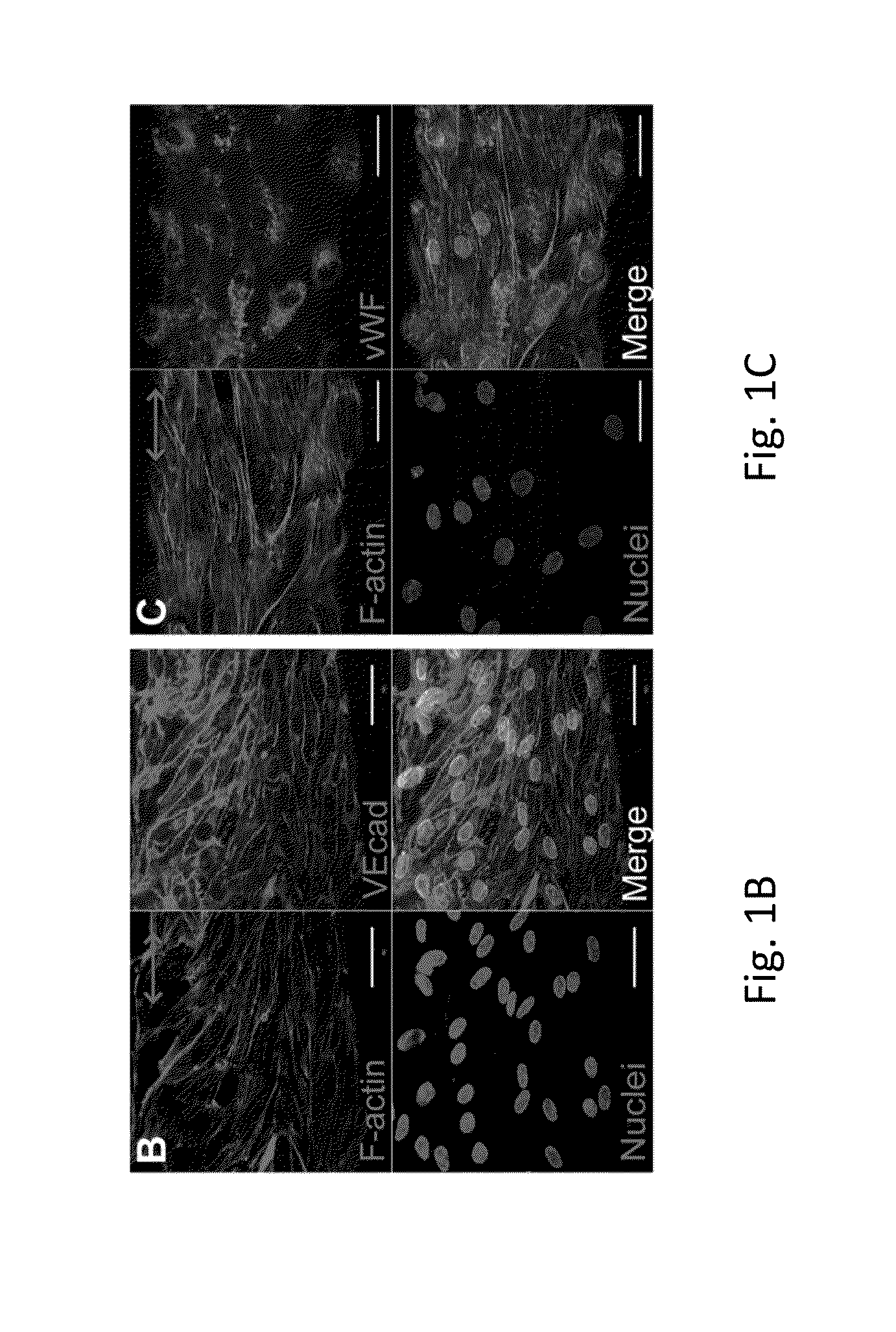Electrostretched polymer microfibers for microvasculature development
a microfiber and electrode technology, applied in general culture methods, biochemical equipment and processes, bioreactors/fermenters, etc., can solve the problems of inability to analyze the organization of different ecm components in detail in microvasculature studies, and the difficulty of creating clinically relevant functional microvascular conduits (i.e. arterioles and venules)
- Summary
- Abstract
- Description
- Claims
- Application Information
AI Technical Summary
Benefits of technology
Problems solved by technology
Method used
Image
Examples
example 1
ECFC Attachment and Alignment on Fibrin Microfibers
[0080]A new approach to create aligned hydrogel microfibers using an electrostretching process of polymer materials is disclosed. Unique characteristics of the electrostretched hydrogel microfibers are the internal and topographical alignment of the fibrous structure, generated as a result of both electrical field and mechanical shear-induced polymer chain alignment as described above. Furthermore, the diameter of a microfiber is controlled and uniform as a result of the bundling and processing of the individual nanofibers that compose the hydrogel microfibers. Fibrin gels have been extensively used to study microvasculature assembly (Dickinson L E, et al., Soft Matter, 2010; 6: 5109-5119; Bayless, K J, and Davis, G E, Biochemical and Biophysical Research Communications, 2003; 312: 903-913; Davis G E, and Bayless K J, Microcirculation, 2003; 10: 27-44; Bayless K J, et al., RGD-Dependent American Journal of Pathology, 2000; 156: 1673...
example 2
ECM Deposition from ECFCs on Fibrin Microfibers
[0088]While the importance of ECM deposition in vascular development has been recognized, few studies have looked at ECM production by the endothelium. ECFCs deposit collagen IV, fibronectin and laminin in an organized web-like structure when cultured on Petri dishes (Kusuma S, et al., FASEB J, 2012; 26: 4925-4936). To establish a reliable in vitro model of microvasculature, we characterized the ECM protein deposition by the endothelium on hydrogel microfibers.
[0089]ECFCs were seeded on fibrin hydrogel microfibers as described in Example 1.
[0090]ECFC seeded on fibrin microfibers deposited laminin, collagen IV, and fibronectin after one day in culture (FIG. 2A). On Day 5, ECFCs completely covered the fibrin microfiber, and abundant ECM deposition was observed (FIG. 2B). In contrast to what was observed previously on Petri-dishes (Kusuma S, et al., FASEB J, 2012; 26: 4925-4936), the ECM proteins deposited by ECFCs on hydrogel microfibers ...
example 3
ECM Deposition from ECFCs on Fibrin Sheets and PES Fibers
[0091]It was previously demonstrated that line-grating topography influences EC adhesion, alignment, and elongation (Ranjan A, and Webster T, Nanotechnology, 2009; 20: 305102; Liliensiek S, et al., Biomaterials, 2010; 31: 5418-5426; Bettinger C J, et al., Adv Mater, 2008; 20: 99-103; Lu J, et al., Acta Biomater, 2008; 4: 192-201). To probe if the aligned nanotopography on fibrin microfibers is responsible for ECFC alignment and coordinated deposition of laminin, collagen IV, and fibronectin, we first examined their deposition on flat (2D) fibrin sheets with similar aligned nanotopography (FIG. 3E) as the fibrin hydrogel microfibers by varying the dimensionality and cylindrical shape of the scaffold.
[0092]Preparation of 2D Fibrin Nanofiber Sheets
[0093]Fibrin-alginate hydrogel nanofibers were prepared according to the same electrostretching method as described in Example 1 above until the collection step in a rotating bath. The ...
PUM
| Property | Measurement | Unit |
|---|---|---|
| diameter | aaaaa | aaaaa |
| diameter | aaaaa | aaaaa |
| diameter | aaaaa | aaaaa |
Abstract
Description
Claims
Application Information
 Login to View More
Login to View More - R&D
- Intellectual Property
- Life Sciences
- Materials
- Tech Scout
- Unparalleled Data Quality
- Higher Quality Content
- 60% Fewer Hallucinations
Browse by: Latest US Patents, China's latest patents, Technical Efficacy Thesaurus, Application Domain, Technology Topic, Popular Technical Reports.
© 2025 PatSnap. All rights reserved.Legal|Privacy policy|Modern Slavery Act Transparency Statement|Sitemap|About US| Contact US: help@patsnap.com



